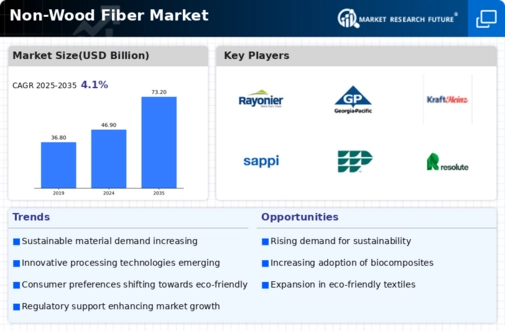Growing Textile Industry
The textile industry is increasingly adopting non-wood fibers due to their versatility and environmental benefits. The Global Non-Wood Fiber Market Industry is experiencing a surge in demand for fibers such as cotton, hemp, and flax, which are favored for their biodegradability and lower environmental impact compared to synthetic fibers. This trend is particularly evident in the fashion sector, where brands are shifting towards sustainable materials to meet consumer preferences. As the textile industry continues to evolve, the market for non-wood fibers is likely to expand, contributing to the overall growth trajectory of the industry.
Market Growth Projections
The Global Non-Wood Fiber Market Industry is poised for substantial growth, with projections indicating a market value of 46.9 USD Billion in 2024 and an anticipated increase to 73.2 USD Billion by 2035. This growth trajectory reflects a compound annual growth rate of 4.13% from 2025 to 2035, driven by various factors including sustainability trends, technological advancements, and increasing consumer demand for eco-friendly products. The market's expansion is likely to create new opportunities for stakeholders across the supply chain, from farmers to manufacturers, as the industry adapts to evolving market dynamics.
Technological Advancements
Innovations in processing technologies are enhancing the efficiency and quality of non-wood fibers, thereby expanding their applications across various sectors. The Global Non-Wood Fiber Market Industry benefits from advancements such as improved extraction methods and fiber treatment processes, which increase yield and reduce costs. For example, developments in biocomposite materials are enabling the integration of non-wood fibers into automotive and construction industries. These technological improvements are likely to support a compound annual growth rate of 4.13% from 2025 to 2035, indicating a promising trajectory for the market as new applications emerge.
Sustainable Material Demand
The increasing global emphasis on sustainability drives the demand for non-wood fibers, as industries seek eco-friendly alternatives to traditional materials. The Global Non-Wood Fiber Market Industry is witnessing a shift towards fibers derived from agricultural residues and other renewable sources. This trend aligns with global sustainability goals, as consumers and manufacturers alike prioritize environmentally responsible practices. For instance, the use of hemp and jute fibers is gaining traction in textiles and packaging, contributing to a projected market value of 46.9 USD Billion in 2024. This growing preference for sustainable materials suggests a robust future for non-wood fibers.
Consumer Awareness and Preferences
Rising consumer awareness regarding environmental issues is shaping preferences towards non-wood fibers. The Global Non-Wood Fiber Market Industry is benefiting from a shift in consumer behavior, as individuals increasingly seek products made from sustainable materials. This heightened awareness is driving brands to adopt non-wood fibers in their offerings, particularly in sectors like packaging and home goods. As consumers prioritize eco-friendly products, companies are responding by integrating non-wood fibers into their supply chains. This trend not only supports market growth but also fosters a culture of sustainability that could redefine industry standards.
Government Initiatives and Policies
Government policies promoting the use of renewable resources are significantly influencing the Global Non-Wood Fiber Market Industry. Many countries are implementing regulations and incentives to encourage the cultivation and utilization of non-wood fibers, which are seen as sustainable alternatives to wood-based products. For instance, subsidies for farmers growing fiber crops can enhance production capacity and lower costs. Such initiatives not only support local economies but also align with global environmental objectives. As a result, the market is expected to grow, reaching an estimated value of 73.2 USD Billion by 2035, reflecting the positive impact of these policies.

















